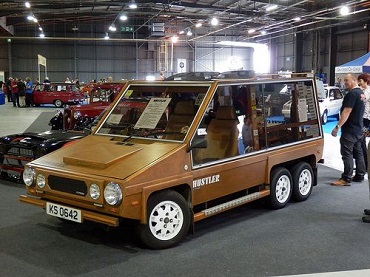What exactly is a Hustler?

The original Hustler was based on the then ubiquitous Mini family car. The 1978 design was from the pen of William Towns, well known designer of the wedge shaped Aston Martin Lagonda. Following wide spread interest interest he developed a range of similar cars through his Interstyl design studio.
At the time small specialist car makers like Lotus were using a two part manufacturing technique. Top and bottoms sections made separately then married in production. The first 4 wheeled Hustler used upper and lower square-section steel frames, clad with glass fibre panels and large flat glass windows. Sliding side windows acted as doors too on the majority of models. Towns called them ‘Windoors’ Like other specialist or kit cars of the era the front and rear sub frames and mechanical components from the Mini, Metro or Allegro were utilised. The Hustler eventually evolved into four and six wheel versions (the six wheel version used two Mini rear sub frames) Anticipating SUV’s many years ahead the style was very much leisure utility in the clean linear design principles inherent in both the Lagonda and the Bulldog.
Again ahead of his time Towns introduced a car to be made of wood such that Mini mechanicals could be exported at low cost and bodies built from trees in then emerging areas. The car was introduced at the 1981 Earl's Court Motor Show called, unsurprisingly, Hustler in Wood. It was constructed from marine plywood box sections and solid hardwood A virtual wooden monocoque. Two GRP ‘Sports’ version was introduced, using the same lower steel structure but with a reduced upper body and one open topped. All models, either built or in kits, were sold by William Towns himself from his Interstyl Studio based at his home estate. Stretton-on-Fosse, near Moreton-in-Marsh, Gloucestershire, England. Proud owners gathered there to show off their own builds.
